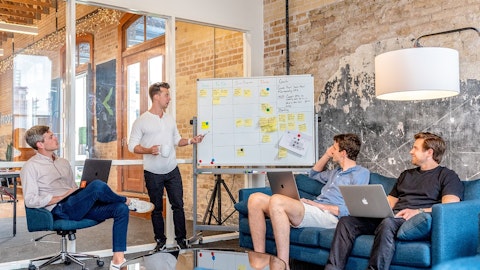Stephen Sheldon: And then just one last one, I guess, just as we head into 2024. How are you guys thinking about the balance of pushing for top line growth versus letting profit ramp more? I know you’re not giving guidance yet but just hope you can provide some high-level thoughts there.
Peter Benevides: Yes. So I think that — this is Peter here. As you think about planning around 2024, we think we’re in a pretty good position to balance both attractive growth and profitability. And I think the — we’ve been proving that out as we move throughout the year in terms of stabilizing in some quarters, reaccelerating growth at the same time, expanding bottom line operating margins. We did that this quarter with a slight reacceleration of growth as well as a slight expansion in operating margins. And we think that we can, as we look ahead to 2024, provide something similar in the form of continued strength in both top line growth as well as operating margin expansion.
Operator: The next question we have is from Matt Hedberg of RBC Capital Markets.
Matthew Hedberg: Noah, just one more for you on Wingstop. Just in terms of thinking about the cadence next year, how should we think about the timing of those locations and thus the revenue rolling off next year?
Noah Glass: Hello, Matt, it’s hard for us to say. We don’t have the specifics of that. What we are communicating is that the current contract ends at the end of March. So we don’t have good visibility beyond that. It’s our practice to have ongoing contract conversations with the brand towards the end of the contract. And that’s what we can have visibility on at this point. I’ll let Peter comment, if you can give more specifics around location and revenue impact as we see it.
Peter Benevides: Yes. So just to pile on there, Matt. So as Noah mentioned, the current contract ends at the end of Q1. At this point, unclear in terms of what that means for the balance of 2024, the final 3 quarters. But what we have shared in terms of relative scale, sub-3% from a revenue standpoint and about 1,800 locations. So the more — as we get more information on what that means for 2024, we’ll obviously share with the group of where we stand today, that’s what we know.
Matthew Hedberg: And then, I guess for either of you. What really stood to me, obviously, the raise for the full year was significantly more than the Q3 beat. And I think in your prepared remarks, you talked about sort of the guidance illustrating confidence in the business. I wonder if you could maybe be a little bit more prescriptive on what exactly is driving that fairly significant rates into Q4? Is it Pay? Is it just general ordering trends? Just maybe a little bit more help on kind of the construct of the raise.
Noah Glass: Yes. So I can take that one, Matt. It is Pay. So what we tried to get across in the prepared remarks is that when we look across the 3 suites, order engage, continue to pace as planned. And a lot of the growth, I should say, the outperformance is being driven by pay. And as we look ahead to the fourth quarter, the beat this quarter being predominantly driven by Pay and kind of fast forward in that — forward for the fourth quarter, we have pretty good conviction and that continuing on through the balance of the year. So that’s really what’s driving the incremental rate for the fourth quarter.
Operator: The next question we have is from Terry Tillman of Truist Securities.
Terrell Tillman: I hope it’s 2 but, look, it maybe 2.5 questions. But the first one is just on card-present. It seems like that’s a big opportunity, if not bigger opportunity TAM-wise [ph]. Could that actually start showing up in the model meaningfully in the first half of ’24 or second half of ’24. And the second part of that first question is, just in general, it’s a bit of a hard question but when do you think gross margins then start to stabilize from just the onslaught of pay. And then I have a follow-up.



